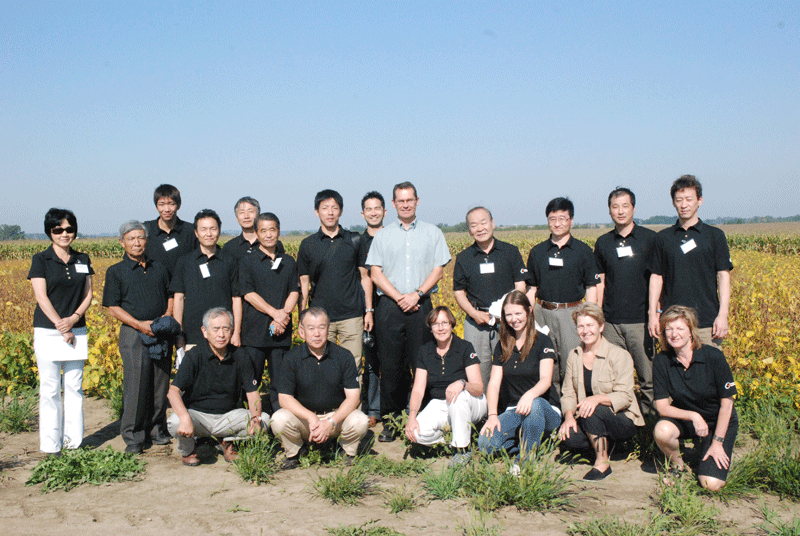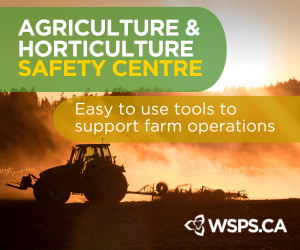Showcasing Canadian soybeans
GROWING OUR RELATIONSHIP WITH JAPAN
japan needs more soybeans than it can grow domestically. Every year, 900,000 tonnes of identity preserved (IP) soybeans are used in food products – half of which are processed into tofu. Manufacturers are looking overseas to meet their demand, and increasingly they are becoming aware of the quality of Canadian soybeans.
Japan is Canada’s largest market for food-grade soybeans. In 2011, Japanese processors imported nearly 330,000 tonnes of Canadian soybeans valued at more than 225 million dollars. Maintaining and building that market is the goal of the CSC Japan-Canada Soybean Program.
welcoming processors
The program is sponsored by the Canadian Soybean Council (CSC), and coordinated by the Canadian International Grains Institute (Cigi). This year, senior representatives from Japanese tofu processing companies spent six days in Canada meeting with researchers, farmers, and industry representatives. They toured farms in Manitoba, Quebec, and Ontario, visited soybean handling and processing facilities, and spent time at breeding and research facilities.
“CSC, together with Cigi, over the past number of years has conducted incoming programs such as this along with outgoing missions to Japan which gives us an opportunity to exchange technical information and to discuss future requirements that benefit both the customer and the Canadian industry,” says Nicole MacKellar, Market Development Coordinator for Grain Farmers of Ontario.
“This is an excellent opportunity for Canada’s soybean industry to demonstrate to these companies how they produce quality soybeans that fit the processing characteristics they require for tofu production,” adds Dr. Linda Malcolmson, Cigi’s Manager of Special Crops, Oilseeds and Pulses.
The 11 participants were nominated by Japan’s National Federation of Tofu Commerce and Trade to attend the program. The Federation consists of nearly 3,000 members representing more than 60 percent of tofu processors in Japan.
PHOTO: THE CSC JAPAN-CANADA SOYBEAN PROGRAM INCLUDED A MEETING WITH DR. ISTVAN RAJCAN AT THE UNIVERSITY OF GUELPH AND A TOUR OF THE SOYBEAN BREEDING PLOTS IN ELORA, ONTARIO.

“Some of them use Canadian soybeans already,” says Tsuneto Sasaki, Trade Commissioner at the Embassy of Canada to Japan in Tokyo. “But some of them don’t know about Canadian soybeans and this program allows them to learn about how the different types of soybeans are grown, the different provinces they are grown in, and how the crops are managed.”
a special connection
This Canadian tour was particularly important for one manufacturer. Jinichi Uemura, director of Uemura Shoten Co. Ltd. in Sendai, Miyagi, has been using Ontario grown soybeans for part of his tofu production since March 2011.
When a 9.0 magnitude earthquake occurred off the east coast of Japan, it triggered a tsunami that devastated much of the region – including the Miyagi prefecture. 120 food processors in the area were damaged and traditional supply chains were cut off. Manufacturers still in operation, like Uemura, struggled to find soybeans they could process into much-needed tofu for the local food supply. Other Federation member companies had the supply they needed, but it took three to four days for the soybeans to be trucked to the region from the Port of Yokohama.
When they finally arrived, Uemura was surprised by the quality of the soybeans, and was impressed to learn that they came from Canada. Before the earthquake, only domestic soybeans were used at his facility, but he now uses a combination of domestic and Canadian IP soybeans.
“We’re proud Mr. Uemura was able to see the full value circle of how soybeans are produced in Canada and the quality parameters we have in place to ensure we are delivering the product he is looking for,” says MacKellar.
meeting the farmers
Presentations during the tour highlighted the Canadian Identity Preserved Recognition System as well as the soybean inspection and grading systems used. The delegates also heard first hand from a farmer about quality control measures. Henry Van Ankum, Chair of Grain Farmers of Ontario, welcomed the tour participants to his farm in Alma, Ontario. He described how he works to keep IP soybeans segregated from his genetically modified (GM) crops during every stage from planting to storage.
“As a farmer I find it rewarding to know we are growing a higher value crop,” Van Ankum told the group. “I like that this program allows me to better understand where my soybeans go to, who’s using them, and why they require the quality they do as an end user.”
The information gathered by the Japanese representatives will be shared with others within the tofu processing industry, as well as the manufacturers of other food products such as miso, natto beans, and soy milk.
“The representatives have formed a good impression of the Canadian soybean industry,” says Sasaki-san. “They now understand how farmers manage their crops and know they are producing the quality their clients are demanding from them.”
This was the fifth Japan-Canada Soybean Program run by the Canadian Soybean Council, a partnership between Grain Farmers of Ontario, Manitoba Pulse Growers Association (MPGA) and La Fédération des producteurs cultures commerciales du Québec (FPCCQ). •





















